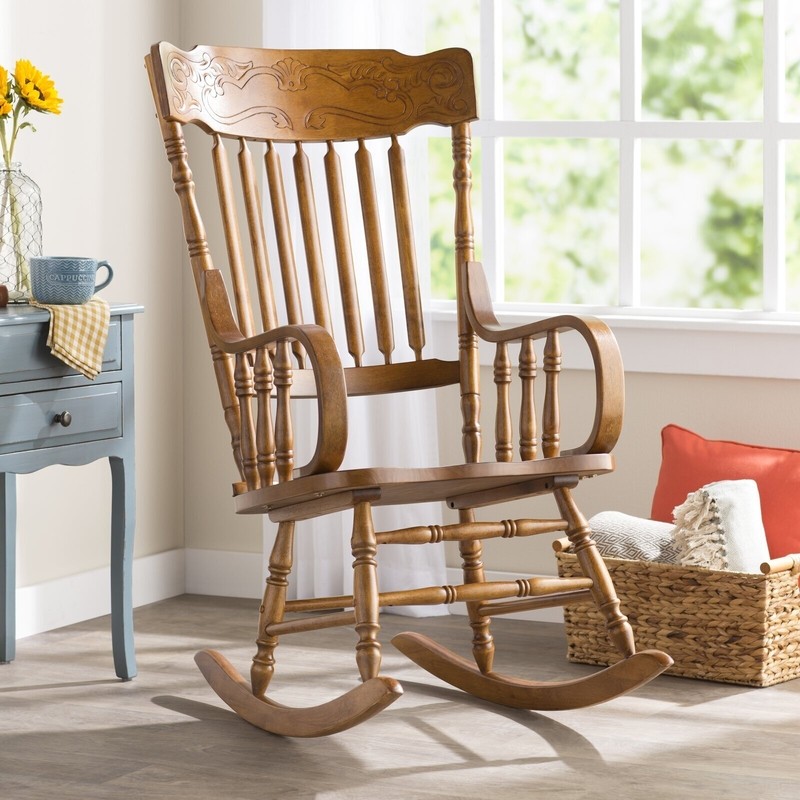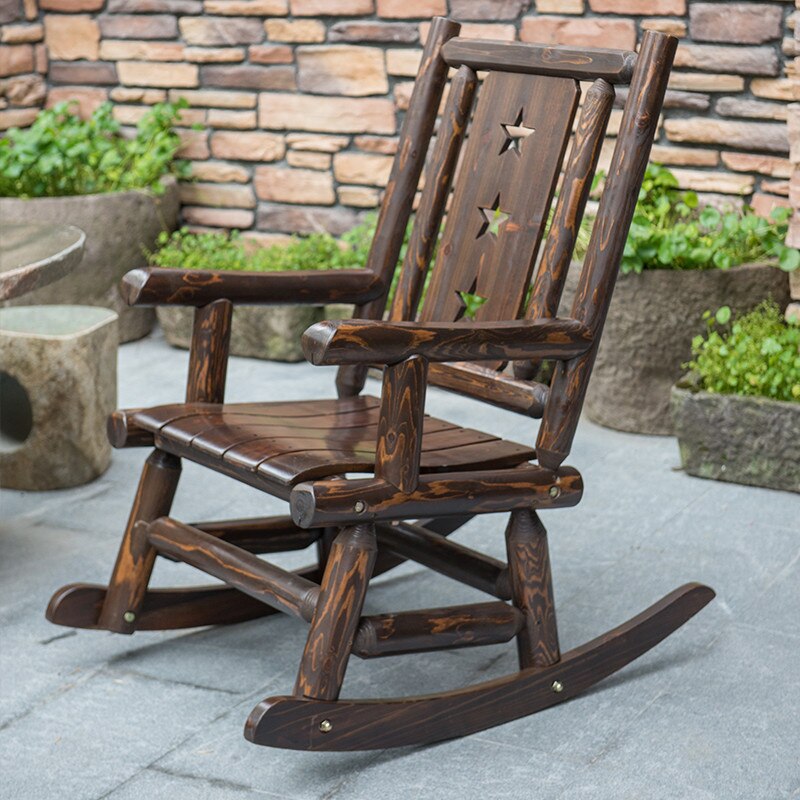History and Origin of Vintage Shaker Rocking Chairs

Shaker rocking chairs, with their elegant simplicity and enduring functionality, are a testament to the enduring legacy of the Shaker community and their profound influence on American furniture design. Their history is intertwined with the origins of Shaker craftsmanship and the evolution of rocking chairs in American homes.
Shaker Craftsmanship and Furniture Design
The Shakers, a religious sect known for their commitment to simplicity, communal living, and craftsmanship, emerged in England in the 18th century and established communities in the United States in the late 1700s. Their philosophy of “plain living and high thinking” permeated all aspects of their lives, including their furniture design. Shaker furniture was renowned for its clean lines, functional forms, and meticulous craftsmanship. They believed that objects should be beautiful in their simplicity and serve a practical purpose.
Rocking Chairs in American Homes
Rocking chairs have been a fixture in American homes since the colonial era. Early rocking chairs were often crudely constructed, but they became more sophisticated over time. The rocking motion was considered soothing and relaxing, and rocking chairs were often placed in living rooms and parlors for social gatherings and quiet contemplation.
Distinctive Features of Shaker Rocking Chairs
Shaker rocking chairs embody the core principles of Shaker design: simplicity, functionality, and durability. They typically feature:
- Simple, unadorned forms: Shaker rocking chairs are characterized by their clean lines and lack of ornamentation. They are designed to be both visually pleasing and practical.
- Solid construction: Shaker rocking chairs were built to last. They were typically made from high-quality hardwoods, such as maple or cherry, and assembled with mortise-and-tenon joints, which are known for their strength and durability.
- Functional design: The rocking motion of Shaker chairs was designed to provide a gentle and rhythmic movement that could be enjoyed for long periods. The chairs were also designed to be comfortable and supportive.
- Slatted backs: Shaker rocking chairs often feature slatted backs, which allowed for ventilation and provided a comfortable backrest.
Prominent Shaker Furniture Makers
Several prominent Shaker furniture makers played a significant role in shaping the design and popularity of Shaker rocking chairs.
- Elder Levi Goodrich: Known for his innovative design and meticulous craftsmanship, Elder Levi Goodrich was a leading figure in Shaker furniture making at the Hancock, Massachusetts, community. He designed a variety of furniture pieces, including rocking chairs, that are still admired for their beauty and functionality.
- Elder Joseph Meacham: As a leading furniture maker at the New Lebanon, New York, community, Elder Joseph Meacham is credited with designing the iconic Shaker rocking chair with a turned spindle back and a curved seat. His designs were characterized by their elegant simplicity and attention to detail.
Design and Construction of Vintage Shaker Rocking Chairs

Shaker rocking chairs, known for their simplicity and functionality, are a testament to the craftsmanship and design principles of the Shaker community. The construction of these chairs embodies a philosophy of practicality, durability, and aesthetic harmony.
Materials and Joinery Techniques
Shaker rocking chairs were primarily constructed using locally sourced hardwoods, such as maple, cherry, and walnut. These woods were chosen for their strength, durability, and natural beauty. The joinery techniques employed by the Shakers were precise and efficient, ensuring the stability and longevity of their furniture. The most common joinery methods included mortise and tenon, dovetail, and pegged construction.
- Mortise and Tenon: This method involves creating a rectangular hole (mortise) in one piece of wood and a corresponding projection (tenon) on another. The tenon is then inserted into the mortise, creating a strong and secure joint.
- Dovetail: This joint is formed by interlocking tapered pins (tails) on one piece of wood with corresponding slots (pins) on another. Dovetail joints are known for their strength and resistance to pulling apart.
- Pegged Construction: Wooden pegs were used to reinforce joints, adding to the stability and durability of the chair. Pegs were often made from the same wood as the chair and were carefully fitted and driven into pre-drilled holes.
Characteristic Design Elements
Shaker rocking chairs are characterized by their minimalist forms, sleek lines, and functional design. They typically feature a simple, rectangular seat, a gently curved back, and elegantly shaped rockers. The chairs were often painted in muted colors, such as white, black, or shades of green and red, to highlight the natural grain of the wood.
- Minimalist Form: The Shaker philosophy emphasized simplicity and functionality. This is reflected in the chairs’ uncluttered design, devoid of unnecessary ornamentation or embellishments.
- Sleek Lines: The smooth, flowing curves of the rockers and the straight lines of the seat and back create a sense of elegance and balance.
- Natural Wood Finishes: The Shakers valued the natural beauty of wood and often used simple finishes, such as oil or wax, to protect and enhance the grain.
Construction Process
The construction of a Shaker rocking chair involved a meticulous and skillful process, requiring precision and attention to detail. Each step was carefully executed to ensure the chair’s durability, functionality, and aesthetic appeal.
| Stage | Tools and Techniques |
|---|---|
| 1. Preparation |
|
| 2. Joinery |
|
| 3. Assembly |
|
| 4. Finishing |
|
Vintage Shaker Rocking Chairs in Modern Interiors

The enduring appeal of vintage Shaker rocking chairs lies in their timeless design and craftsmanship. These pieces seamlessly blend with contemporary aesthetics, offering a touch of history and elegance to modern living spaces.
Aesthetic Appeal of Vintage Shaker Rocking Chairs
Vintage Shaker rocking chairs possess a distinct aesthetic that sets them apart from contemporary furniture styles. Their simple, uncluttered lines and minimalist design embody the Shaker philosophy of functionality and practicality. This understated elegance complements a wide range of modern interior design schemes, from minimalist and Scandinavian to eclectic and bohemian.
Integrating Vintage Shaker Rocking Chairs into Modern Interiors
Vintage Shaker rocking chairs can be incorporated into various modern interior design schemes, adding a touch of history and character to contemporary spaces.
- Minimalist Interiors: The clean lines and understated design of a vintage Shaker rocking chair perfectly complement minimalist interiors. The chair’s natural wood finish adds warmth and texture to a predominantly neutral palette. A vintage Shaker rocking chair placed in a minimalist living room with a white sofa, sleek coffee table, and geometric artwork creates a harmonious and inviting space.
- Scandinavian Interiors: The simplicity and functionality of vintage Shaker rocking chairs align well with the Scandinavian design aesthetic. The chair’s natural wood finish blends seamlessly with the light and airy palette of Scandinavian interiors. A vintage Shaker rocking chair paired with a light-colored sofa, a sheepskin rug, and natural wood accents creates a cozy and inviting Scandinavian-inspired living room.
- Eclectic Interiors: Vintage Shaker rocking chairs can be used to add a touch of traditional charm to eclectic interiors. The chair’s classic design provides a grounding element to a space that features a mix of styles and patterns. A vintage Shaker rocking chair placed in an eclectic living room with a patterned rug, vintage artwork, and a mix of modern and antique furniture creates a unique and personal space.
- Bohemian Interiors: Vintage Shaker rocking chairs can add a touch of rustic charm to bohemian interiors. The chair’s natural wood finish complements the earthy tones and natural textures often found in bohemian spaces. A vintage Shaker rocking chair placed in a bohemian living room with a macrame wall hanging, a vintage rug, and a mix of plants creates a cozy and eclectic space.
Challenges and Considerations for Incorporating Vintage Furniture
Incorporating vintage furniture into contemporary spaces can present challenges and require careful consideration.
- Style Compatibility: It is important to ensure that the vintage furniture piece complements the overall style of the space. For example, a vintage Shaker rocking chair might not be the best choice for a modern industrial loft, but it could work well in a farmhouse-style living room.
- Size and Scale: Vintage furniture can sometimes be large or bulky, so it is important to consider the size and scale of the piece in relation to the size of the room.
- Condition: Vintage furniture may require restoration or repair. It is important to assess the condition of the piece before purchasing it and factor in any potential restoration costs.
- Color and Finish: Vintage furniture often has a unique patina or finish that may not match the color scheme of a contemporary space. It may be necessary to refinish or repaint the piece to achieve a cohesive look.
Hypothetical Living Room Design
Imagine a cozy living room with a vintage Shaker rocking chair as the focal point. The chair, with its warm wood finish and gently rocking motion, invites relaxation and contemplation. It sits beside a large, plush sofa covered in a neutral fabric like linen or cotton. A coffee table with a simple, geometric design sits between the sofa and the rocking chair. A large window floods the space with natural light, highlighting the textures and colors of the room. A vibrant rug with geometric patterns adds a pop of color and texture to the space, while a collection of framed artwork on the walls adds visual interest and personality. The overall effect is a balanced and inviting space that combines the timeless elegance of vintage furniture with the modern simplicity of contemporary design.
Vintage Shaker rocking chairs are known for their simple, elegant design and sturdy construction. If you’re looking for a modern take on this classic, consider a tractor supply white rocking chair. These chairs often feature a similar style but with a fresh, updated look that can complement any décor.
Whether you choose a vintage Shaker or a modern white rocking chair, you’re sure to enjoy the gentle rocking motion and timeless charm of this classic piece of furniture.
Vintage Shaker rocking chairs are known for their simple elegance and timeless appeal. If you’re looking for a more modern take on the classic rocking chair, consider an indoor black rocking chair which can bring a touch of sophistication to any room.
Whether you choose a vintage Shaker or a contemporary black rocking chair, you’ll enjoy the soothing motion and cozy comfort they provide.